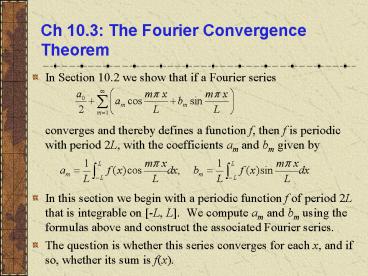Ch 10'3: The Fourier Convergence Theorem PowerPoint PPT Presentation
1 / 13
Title: Ch 10'3: The Fourier Convergence Theorem
1
Ch 10.3 The Fourier Convergence Theorem
- In Section 10.2 we show that if a Fourier series
- converges and thereby defines a function f, then
f is periodic with period 2L, with the
coefficients am and bm given by - In this section we begin with a periodic function
f of period 2L that is integrable on -L, L. We
compute am and bm using the formulas above and
construct the associated Fourier series. - The question is whether this series converges for
each x, and if so, whether its sum is f(x).
2
Fourier Series Representation of Functions
- To guarantee convergence of a Fourier series to
the function from which its coefficients were
computed, it is essential to place additional
conditions on the function. - From a practical point of view, such conditions
should be broad enough to cover all situations of
interest, yet simple enough to be easily checked
for particular functions. - To this end, we recall from Chapter 6.1 the
definition of a piecewise continuous function on
the next slide.
3
Piecewise Continuous Functions
- A function f is piecewise continuous on an
interval a, b if this interval can be
partitioned by a finite number of points - a x0 lt x1 lt lt xn b such that
- (1) f is continuous on each (xk, xk1)
- The notation f(c) denotes the limit of f(x) as
x? c from the right, and f(c-) denotes the limit
of f(x) as x? c from the left. - It is not essential that the function be defined
at the partition points xk,, nor is it essential
that the interval a, b be closed.
4
Theorem 10.3.1
- Suppose that f and f ' are piecewise continuous
on -L, L). - Further, suppose that f is defined outside -L,
L) so that it is periodic with period 2L. - The f has a Fourier series.
- where
- The Fourier series converges to f(x) at all
points x where f is continuous, and to f (x)
f (x-)/2 at all points x where f is
discontinuous.
5
Theorem 10.3.1 Discussion
- Note that the Fourier series converges to the
average of f (x) and f (x-) at the
discontinuities of f. - The conditions given in this theorem are only
sufficient for the convergence of a Fourier
series they are not necessary. Nor are they the
most general sufficient conditions possible. - Functions that are not included in the theorem
are primarily those with infinite discontinuities
in -L, L), such as 1/x2. - A Fourier series may converge to a function that
is not differentiable or continuous, even though
each term in the series is continuous and
infinitely differentiable. - The next example illustrates this, as does
Example 2 in Section 10.2.
6
Example 1 Square Wave (1 of 8)
- Consider the function below.
- We temporarily leave open the definition of f at
x 0 and x ?L, except to say that its
value must be finite. - This function represents a square wave, and is
periodic with period T 2L. See graph of f
below.
7
Example 1 Square Wave (2 of 8)
- Recall that for our function f,
- The interval -L, L) can be partitioned to give
two open subintervals (-L, 0) and (0, L). - On (0, L), f(x) L and f '(x) 0. Thus f and f
' are continuous and have finite limits as x ? 0
from right and x ? L from left. - Similarly on (-L, 0). Thus f and f ' are
piecewise continuous on -L, L), and we can apply
Theorem 10.3.1.
8
Example 1 Coefficients (3 of 8)
- First, we find a0
- Then for am, m 1, 2, , we have
- Similarly, for bm 0, m 1, 2, ,
9
Example 1 Fourier Expansion (4 of 8)
- Thus am 0, m 1, 2, , and
- Then
10
Example 1 Theorem 10.3.1 (5 of 8)
- Thus
- Now f is continuous on (-nL, 0) and (0, nL),
hence the Fourier series converges to f(x) on
these intervals, by Theorem 10.3.1. - At the points x 0, ?nL where f is
discontinuous, all terms after the first vanish,
and the sum is L/2 f (x) f (x-)/2. - Thus we may choose to define f (x) to be L/2 at
these points of discontinuity, for then series
will converge to f at these points.
11
Example 1 Gibbs Phenomena (6 of 8)
- Consider the partial sum
- The graphs of s8(x) and f are given below for L
1. - The partial sums appear to converge to f at
points of continuity while they tend to overshoot
f near points of discontinuity. - This behavior is typical of Fourier series at
points of discontinuity and is known as Gibbs
phenomena.
12
Example 1 Errors (7 of 8)
- To investigate the convergence in more detail, we
consider the error function en(x) f (x) -
sn(x). - Given below is a graph of e8(x) and L 1. The
least upper bound of e8(x) is 0.5, and is
approached as x ? 0 and x ? 1. - As n increases, the error decreases on (0, 1),
where f is continuous, but the least upper bound
for the error does not diminish with increasing
n. - Thus we cannot uniformly reduce
- the error throughout the interval by
- increasing the number of terms.
13
Example 1 Speed of Convergence (8 of 8)
- Note that in our Fourier series,
- the coefficients are proportional to 1/(2n-1).
- Thus this series converges more slowly than the
one in Examples 1 and 3 of Section 10.2, whose
coefficients are proportional to 1/(2n -1)2.

